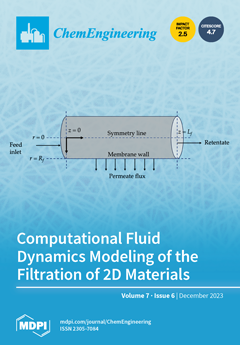The use of an ozonized bubble column reactor (OBCR) in wastewater treatment is advantageous due to its efficient mixing and mass transfer characteristics. Among all high-performance features, the ozonation reaction in a BCR undergoes a low dissolution of O
3 in the reactor with a limited reaction rate. In this study, the ozonation reaction of phenol in an OBCR was tested using a ZnO nanocatalyst and alumina balls as packing material. Three concentrations of O
3 were evaluated (i.e., 10, 15, and 20 ppm), and 20 ppm was found to be the optimum concentration for phenol degradation. Also, two doses (i.e., 0.05 and 0.1 g/L) of ZnO nanocatalysts were applied in the reaction mixture, with the optimal dose found to be 0.1 g/L. Accordingly, three phenol concentrations were investigated in the OBCR (i.e., 15, 20, and 25 ppm) using four treatment methods (i.e., O
3 alone, O
3/Al
2O
3, O
3/ZnO nanocatalyst, and O
3/Al
2O
3/ZnO nanocatalyst). At a contact time of 60 min and phenol concentration of 15 ppm, the removal rate was 66.2, 73.1, 74.5, and 86.8% for each treatment method, respectively. The treatment experiment that applied the O
3/Al
2O
3/ZnO nanocatalyst produced the highest phenol conversion into CO
2 and H
2O in the shortest contact time for all phenol concentrations. Thus, the OBCR employed with a ZnO nanocatalyst plus packing material is a promising technology for the rapid and active removal of phenol because it enhances the number of hydroxyl radicals (•OH) generated, which ultimately increases the oxidation activity in the OBCR. Also, the results showed efficient flow characteristics in the OBCR, with channeling problems averted due to appropriate gas movement resulting from the use of packing materials. Finally, it was found that the ozonation process in an OBCR is an efficient method for phenol conversion with good economic feasibility.
Full article





